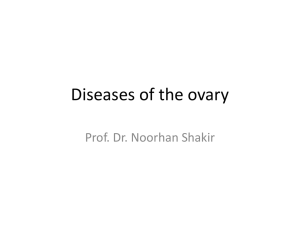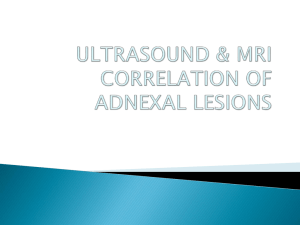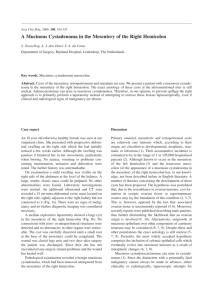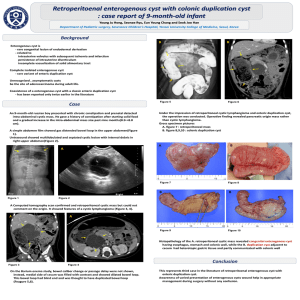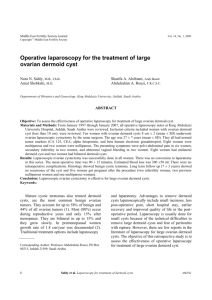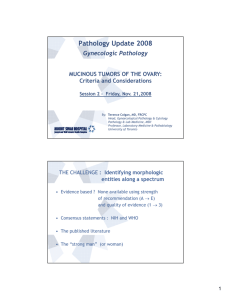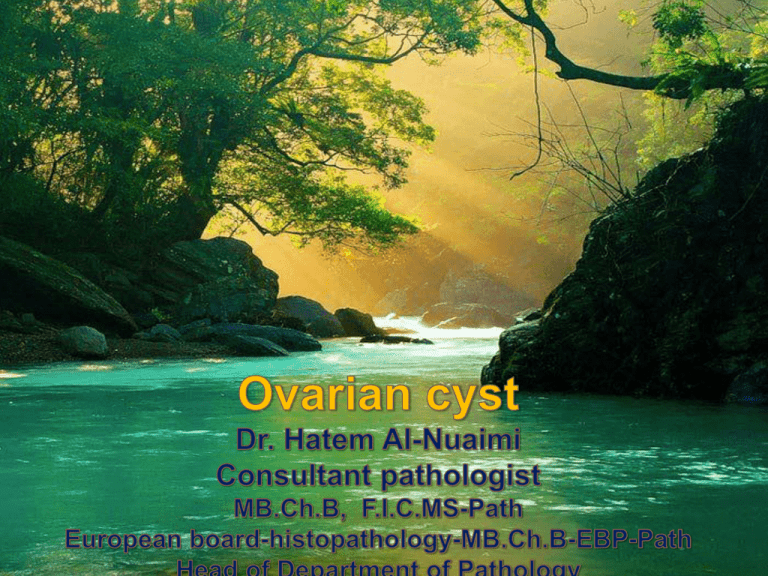
Epidemiology of Ovarian Cysts?
Many types.
Different causes.
Many women will have cysts during their
childbearing years.
Most are asymptomatic.
Some types can cause serious health
problems.
Questions ????????
1-classification.
2-causes.
3-Diagnosis.
Ovarian Cysts
Non Neoplastic
- Physiological:(Functional)
* Follicular.
* Corpus Luteum.
* Theca Lutein.
- Pathological
* Endometriotic.
* PCOS.
- Inflammatory
Neoplastic
- Epithelial.
- Sex Cord.
- Germ Cell.
- Others (
Metastatic….)
Causes(pathogenesis)
.
The exact cause of ovarian cysts is not known, but they tend to
form when the ovary produces too much of the hormone
estrogen
Some ovarian cysts are caused by a hormonal irregularity
called polycystic ovarian syndrome in which the entire ovary is
filled with numerous cysts that are causing abnormal amounts of
hormonal production.
Other times cysts can be caused by tumors, which can be either
benign or cancerous.
Functional cyst
- Follicular cysts
Follicular cysts are the most commonly seen ovarian cysts.
They occur in reproductive life and can be confused with
neoplastic lesions. Each egg forms in a tiny structure inside the
ovary called a follicle. The follicle contains fluid to protect the
egg as it grows and it bursts when the egg is released.
Sometimes a follicle does not release an egg, or it does not
shed its fluid and shrink after the egg is released. If this
happens, the follicle can get bigger as it swells with fluid. The
fluid-filled follicle becomes a follicular ovarian cyst.
Usually, only one cyst appears at a time and it will often
disappear without treatment after a few weeks
Cont- Follicular Cyst:
Most follicular cysts are unilateral and measure 1 - 10 cm.
The maximum measurement of a normal follicular cyst is 2.5cm.
luteinized follicular cyst of the ovary. H&E stain.
2- Corpus Luteum:
Occurs when the dominant follicle ruptures successfully.
In the absence of a pregnancy, the corpus luteum normally collapses and
becomes the corpus albicans.
Unusual continued growth and / or hemorrhage may create a cyst.
Measure 1.5 - 2.5 cm in diameter and may contain internal blood.
- Less common than follicular cysts.
- Rupture leading to hemoperitoneum(acute abd).
- Most ruptures occur on cycle days 20 ~ 26
3- Corpus Luteum of Pregnancy:
In the presence of hCG, the ruptured follicle undergoes
cystic enlargement.
This structure usually regresses spontaneously by the
12th week.
Microscopically
4- Theca Luteum:
Cystic enlargement of atretic follicles.
Most commonly are associated with hydatidiform mole and other
types of gestational trophoblastic disease.
The least common.
- Bilateral.
- Size: quite large (~30cm), multicystic, regress spontaneoustly.
Neoplastic cyst
ENDOMETRIOTIC
MUCINOUS
SEROUS
Cystadenomas
Cystadenomas are common cystic epithelial tumors occurring on
the ovary.
These cysts may grow very large and are most frequently seen
in women between 50 - 60 years of age.
It is impossible to differentiate histologic types
sonographically.
Septations and papillary excrescences may be seen.
Three histologic types exist:
1- Serous Cystadenomas.
2- Mucinous Cystadenomas.
3- Cystadenofibroma
1- Serous Cystadenoma
A unilocular or multilocular cyst lined by epithelium similar to the
fallopian tube.
Contains serous fluid.
They are the most common benign epithelial tumors and form
20% of all ovarian neoplasm.
In about 10% of cases they are bilateral.
It is uncommon to find them large than a fetal head.
More common in women 40 - 50 y.
Serous Cystadenoma
Serous cystadenoma, ovary
2- Mucinous Cystadenoma
A unilocular or multilocular cyst of ovary lined by tall columnar
epithelium resembling that of the cervix or large intestine.
It is usually large and may reach immense proportions, occupying
the whole peritoneal cavity and compressing other organs.
It may occur at any age but more common in women 30 - 50
years of age.
Contains thicker mucinous fluid.
Rarely bilateral (5 - 7%).
Low malignant potential.
Only 1 in 7 become malignant.
20% of epithelial tumors.
• Rupture may occur and seeding of
the epithelium on the peritoneal
surface may cause pseudomyxoma
peritonei.
Mucinous Cystadenoma
Cystadenofibroma
Variant of serous type.
Unilateral.
Partly cystic and partly solid.
Ovarian Cystadenofibroma
Pseudomyxoma Peritonei
This rare condition occasionally but not inevitably follows the rupture
of a mucinous cystadenoma.
The epithelial cells implant on the peritoneum and continue to secrete a
gelatinous pseudomucin which is not absorbed, or secretion is faster
than absorption.
The abdominal cavity is eventually filled with the jelly, while the
secreting cells spread over the parietal and visceral peritoneum.
Polycystic Ovaries
An endocrine disease that results in the over-production of cysts
within the ovaries is known as PCO or Stein-Levinthal Syndrome.
Most commonly found in adolescent girls and young women (teens twenties).
Diagnosis of PCO is actually a clinical / serological diagnosis and not
necessarily a sonographic diagnosis.
Clinical Findings:
Obesity
Oligomenorrhea or amenorrhea
Hirsutism
Infertility
Polycystic Ovary Disease (Stein-Leventhal Syndrome)
Serous Cystadenocarcinoma
This is by far the commonest primary carcinoma, accounting for
60% of all cases, and in over half the cases it is bilateral.
The cysts are always of papillary type and the epithelium burrowing
through the capsule produces papillary processes on the serous
surface.
Extension of the growth to the pelvis and adjacent organs fixes
the tumor.
Ascites is always present.
Serous cystadenocarcinoma, ovary
Serous papillary cystic tumor of borderline
malignancy.
Serous papillary cystic tumor of borderline
malignancy.
White polypoid excrescences that were soft
arise from the lining of the cyst.
There is extensive, orderly invagination of the
neoplastic glands, most with intraluminal
papillae, into the stromal component of the
neoplasm. The stroma is unaltered in
appearance.
Mucinous Cystadenocarcinoma
This is only a third as common as the serous variety.
Malignancy in a mucinous cyst is characterized by the formation
of areas of solid carcinoma in the wall.
The cells are columnar, show mitoses and tend to form glandular
structures.
Mucinous cystadenocarcinoma - papillary
Multilocular mucinous cystic tumor.
Mucinous cystic tumor of borderline malignancy.
Edematous papillae have a prominent inflammatory cell infiltrate.
Mucinous Cystadenocarcinoma
Endometrioid Carcinoma of the Ovary
Usually the lesion is cystic and chocolate brown in color.
If such a cyst ruptures spontaneously, malignancy should be
suspected.
The histology varies as in uterine carcinoma.
It may be a well-differentiated adenocarcinoma, an adenoacanthoma, mucinous adenocarcinoma or clear-celled carcinoma.
Serous, mucinous, endometrioid, and clear cell tumors of the
ovary are for the most part cystic lesions, and aspirates usually
yield some fluid.
The most common neoplasm is the serous type, which yields
groups of cells in papillary, acinar, and single forms.
Psammoma bodies may be encountered in aspirates, but this
feature is present in only a minority of cases
Differences Between Benign & Malignant
Benign
Malignant
Unilateral
Bilateral
Cystic
Solid component
Unilocular
Multilocular
Stable over time
Growth
No ascites
Ascites
Teratomas
Cystic teratomas are the most common benign tumor of the ovary
and usually occur in women ages 20 – 30 and frequently they are
bilateral.
These masses are also frequently referred to as dermoids but a
distinction between dermoids and teratomas exists.
Dermoids (derived from two germ cell layers) are always benign,
teratomas (derived from three germ cell layers) maintain a
malignant potential.
Teratomas are ovoid and unilocular and as they mature they may
form teeth, hair and glandular tissue.
The wall consists of dense fibrous tissue lined by stratified
squamous epithilium.
Thick yellow sebacious material fill the cyst.
Many teratomas are located superior to the fundus of the uterus
making them a potential easy miss with sonographic evaluation.
Dermoid Cyst
Benign cystic teratoma, ovary
Stromatous Tumours Germ Cell
Tumours
.Fibroma or sarcoma.
.Dysgerminoma.
.Teratoma.
.Gonadoblastoma.
.Yolk sac tumour.
.Carcinoid
.Thyroid tumour Choriocarcinoma
Hormone-Producing Tumors
Estrogen-producing:
Granulosa cell tumour.
Thecoma.
Androgen-prodicing:
Sertoli-Leydig cell tumour (Arrhenoblastoma).
Hilar cell tumour.
Lipoid cell tumour.
Krukenberg Tumour
There is one well-known secondary tumour of the
ovary, the krukenberg
of a stomach carcinoma.
tumour, a secondary
CA-125
CA-125 (cancer antigen 125 or carbohydrate antigen 125)
also known as mucin 16 or MUC16 is a protein that in humans
is encoded by the MUC16 gene. MUC16 is a member of the
mucin family glycoproteins. CA-125 has found application as a
tumor marker or biomarker that may be elevated in the blood
of some patients with specific types of cancer, or other benign
conditions.
As a biomarker
CA-125 is clinically approved for following the response to
treatment and predicting prognosis after treatment. It is
especially useful for detecting the recurrence of ovarian tumor.
Its potential role for the early detection of ovarian cancer
In April 2011 the UK's National Institute for Health and Clinical
Excellence (NICE) recommended that women with symptoms
that could be caused by ovarian cancer should be offered a
CA-125 blood test. The aim of this guideline is to help
diagnose the disease at an earlier stage, when treatment is
more likely to be successful. Women with higher levels of the
marker in their blood would then be offered an ultrasound
scan to determine whether they need further tests.
ovarian cyst US
Unilocular
Multilocular
- Heterogeneous
-Homogenous
-Thick walls
-Thin walls
-vegetation
-No vegetation
C.A. 125
<35
>35
Observe 2 months
Stable or <5cm
Observe 6 months
>5cm
Aspiration by U.S.
Cytology
Benign
Laparoscopy or laparotomy
Suspicious

